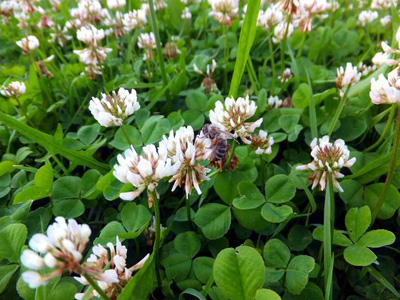ADDING WHITE CLOVER TO THE SWARD
 Grass and clover mixtures produce scientifically proven yield benefits, compared to the same varieties sown individually. White clover has been selected to withstand being grazed or cut, so the choice of companion grass depends on the primary use of the sward, ie grazing or cutting. The ideal grass is typically ryegrass, as it has good nitrogen use efficiency.
Grass and clover mixtures produce scientifically proven yield benefits, compared to the same varieties sown individually. White clover has been selected to withstand being grazed or cut, so the choice of companion grass depends on the primary use of the sward, ie grazing or cutting. The ideal grass is typically ryegrass, as it has good nitrogen use efficiency.
This means it can successfully convert the nitrates produced by the clover into plant yield. Research carried out by Teagasc has shown increased Dry Matter (DM) yields of 2 tonne/DM ha (Dry matter/hectare) from White Clover and Perennial ryegrass swards versus a pure Perennial ryegrass sward.
The optimum amount of clover in a field is 30% of the DM of the total sward. At this level, clover can fix 150kg N/ha per year and both animal and companion grass performance will benefit from it being there.
OVER-SEEDING CLOVER INTO EXISTING GRASSLAND
- Suitable on well-managed grassland – not suitable on old ‘butty’ swards of poor botanical composition:
- Minimise competition from existing plants before sowing by heavy grazing or harrowing to open up the sward:
- Ensure that field fertility is adequate – good lime, P & K levels:
- Ensure soil is sufficiently disturbed to allow seed-to-soil contact and coverage:
- Use a higher seed rate (4kg/ha or 1.5kg/acre) than conventional sowing to compensate for greater seedling loss:
- Apply no fertiliser N for the remainder of the year. The objective is to reduce grass competition and to promote clover growth:
- Mix seed and fertiliser in the field and spread twice – criss-cross the field:
- Apply slurry as required – ideally around 3000gals/acre of watery slurry:
- After sowing graze hard in short intensive three to four day periods every month, until clover is well: established, to reduce competition from other plants.
.
|
SOWING INFORMATION Sowing time: April/May – August Sowing rate: 0.5 kg – 1.5kg/acre (plus 13 kg PRG) 2 - 3 kg/acre (overseed) |
YIELD & FEED QUALITY (Grass plus white clover) Average DM yield: 12 – 14 tonne DM/ha Dry Matter: 12 – 15% Crude protein: 18-25% Digestibility: 70 - 72% (DMD) Metabolisable energy: 10.5 – 11.5 Mj/kg DM |
